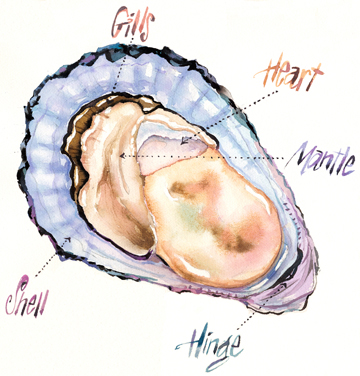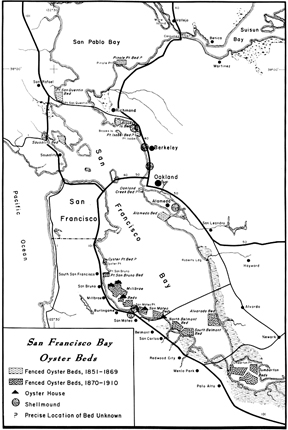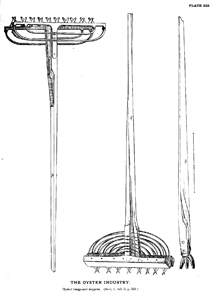History on the Half Shell
Susan Pultz Williams
 Next
time you lift a finely-fluted oyster shell to your lips and
slurp down the plump cold meat that tastes something like
the sea on a fresh clear day, consider this: you’re not just
eating a rich appetizer—you’re taking part in a timeless
dining ritual. You’re enjoying what native Californians
enjoyed in ancient times, what the gold miners prized after
a hard days work, what Jack London wrote stories about, and
what food connoisseurs in California and around the world
continue to crave. Passion for oysters is as old as the
hills surrounding San Francisco and Tomales Bays, hills that
have seen oysters come and go for thousands of years.
Next
time you lift a finely-fluted oyster shell to your lips and
slurp down the plump cold meat that tastes something like
the sea on a fresh clear day, consider this: you’re not just
eating a rich appetizer—you’re taking part in a timeless
dining ritual. You’re enjoying what native Californians
enjoyed in ancient times, what the gold miners prized after
a hard days work, what Jack London wrote stories about, and
what food connoisseurs in California and around the world
continue to crave. Passion for oysters is as old as the
hills surrounding San Francisco and Tomales Bays, hills that
have seen oysters come and go for thousands of years.
In prehistoric times, oysters thrived in
the Bay and were a diet staple of the Ohlone and Coast Miwok,
who lived in small villages beside the Bay’s creeks,
streams, and tidal wetlands. The mounds of shells that they
left behind, mostly oyster, mussel, and bentnose clam
shells, provide evidence that these native Californians
enjoyed an abundant shellfish population for many millennia.
Seventeenth-century Spanish explorers found shell mounds,
also called “middens,” as long as football fields and as
tall as 2- or 3-story buildings. Studies of the middens and
of ancient shell reefs long buried under Bay sediment
suggest that the oyster population peaked more than 2,000
years ago.
 |
| Map of Bay
Area oyster beds 1851-1910. Illustration from
The California Oyster Industry, by Elinore M.
Barrett, California Department of Fish and Game
Fish Bulletin No. 123, courtesy Maritime Museum
Porter Library. |
We don’t know how the Bay’s native
oysters, Ostrea lurida, fared after that, but we do know
they were rediscovered by immigrants drawn to the Bay Area
by the Gold Rush. In the early Gold Rush days, miners paid
$20 a plate for Bay oysters, but were soon passing them up
in favor of John Stillwell Morgan’s imports from Shoalwater
Bay (now Willapa Bay) in Washington State. Called Olympias,
or Olys, the imports were the same species, but larger,
tastier, and more abundant. Soon oystermen began to store
and grow Olys in artificial beds along Sausalito’s
shoreline. Underwater fences kept out aquatic predators, but
could not hold back the tons of silt and mud washed down to
the Bay by hydraulic mining operations in the Sierra Nevada.
To avoid the silt, Morgan and other oystermen moved their
beds to Millbrae and the South Bay.
Then, after the transcontinental railroad was complete in
1869, oystermen began shipping East Coast oysters in from
New York. Packed in wooden barrels with plenty of ice, the
dime-sized Crassostrea virginica arrived at the Bay to be
fattened up in the artificial beds, and soon became more
popular than the Olys. Demand for the eastern “sea fruit”
grew and reached a peak in the ’90s when more than 250 train
car loads of oyster seed were shipped in and 2.7 million
pounds of mature oysters were harvested.
| Hog Island Oyster
Company If you like
half-shell oysters—raw, briney, and ice-cold,
you’ll want to try Hog Island Oysters from
Tomales Bay. Each year, Hog Island
aquaculturalists lift more than three million
plump, sea-sweet oysters with beautifully fluted
shells, from the pristine waters of Tomales Bay.
Oysters thrive in these waters, where
temperatures stay cool all year long, healthy
phytoplankton provide an abundant food supply,
and fresh water from springs and creeks mix with
salt water from the ocean. Hog Island received
the “Award of Excellence for Animal Husbandry”
from the American Institute of Food & Wine and
“The Best American Oyster” award from the San
Francisco Chronicle.
Hog Island proprietors Michael
Watchorn and John Finger started their company
in 1982 in a small, historic west Marin village
called Marshall, which once was a commercial
fishing town and a stop on the rail line that
moved seafood along the California coast.
Enjoying the history, they bought the
century-old Marshall General Store to house
their business, but mostly they were drawn to
Tomales Bay and its prime conditions for oyster
cultivation.
It took Watchorn and Finger
years to perfect their oysters; they modified
the labor-intensive, single-seed method of
farming until they got the results they wanted.
Now they use an 18-month-long process that
entails buying seedlings from hatcheries, then
planting the quarter-inch long seeds, called
spats, onto pieces of shell. Enclosed in mesh
cylinders, the spats grow to about one inch in
length, then are moved to mesh bags which are
tied to racks in the water. There the juveniles
stay until they grow to three to four inches and
are ready for harvesting. The mesh cylinder
stage is especially critical for producing an
attractive shell: as the cylinders roll with the
tide, the water thickens the shells and creates
the deep cup.
Hog Island follows meticulous
farming practices that ensure the health of
their oysters. A wet-storage system designed by
proprietor Terry Sawyer pumps sea water from the
Bay into tanks and sterilizes the water with
ultraviolet light. The chilled tanks hold a
fresh supply of live oysters when slight
declines in water quality require harvest
closures. Because of federal regulations and
regular testing, the oyster farming practices
are even safer than they need to be.
While you can find Hog Island
oysters at fine restaurants and seafood bars,
there’s nothing like a trip to Marshall to enjoy
oysters just pulled from the Bay. Hog Island
provides barbecue grills and picnic tables for
its customers, along with shucking gloves,
knives, instructions.
Visit the Hog Island Oyster Bar in San
Francisco’s Ferry Building Marketplace, Shop
#11-1. For information, call (415) 391-7117 or
e-mail hogislnd@svn.net. The mailing address is:
Hog island Oyster Company; P.O. Box 829,
Marshall, CA 94940. |
During these years, the heyday of
commercial oyster production in the Bay, hundreds of acres
of San Mateo County’s tidal mudflats were virtually paved
with oysters. Oyster pirates like Jack London, roving in
gangs, snuck into the commercial beds at night and stole
small boatloads of oysters. Then later, as London describes
in his short story from 1905, “A Raid on the Oyster
Pirates,” he joined the side of the law and helped bust the
poachers.
Around the turn of the
century, the Bay-grown eastern oysters began to fail, the
victims of raw sewage and industrial pollution; they were
blamed for several typhoid outbreaks. As production dwindled
and public suspicion mounted, oystermen moved their beds to
other west coast bays. Untouched by industrial
contamination, Tomales Bay, a narrow, 22-mile-long inlet
located 50 miles northwest of San Francisco, became a
preferred oyster growing spot. Oyster production in San
Francisco Bay stopped completely by 1939, but continued to
expand in Tomales Bay, where the industry still thrives.
A few oyster companies have settled in
Tomales Bay, now a National Marine Sanctuary, because it
offers the clean, cold water, abundant phytoplankton blooms
and tidal action necessary for growing rich-tasting oysters
with beautiful shells. Among these aquaculturalists, the Hog
Island Oyster Company started up in 1982 and now sells more
than 3 million oysters each year to fine restaurants around
the country. Hog Island grows four types of oysters, all of
them imports: the Pacific (also known as the Japanese
oyster), Eastern, European, and Kumamoto. (See inset.)
But in San Francisco Bay, oysters are scarce.
Siltation and contaminants continue to threaten the native
Olympia oysters (Ostrea lurida), as well as the entire
ecosystem; the more than 200 invasive non-native species
living in the Bay include exotics that prey on oysters,
crowd them out or consume their food supplies.
 |
| Oyster
tongs and nippers, used to bring oysters up from
the water bed. Tomales Bay cultivators grow
oysters in nets instead. Fishery Industries of
the United States, United States Commission of
Fish and Fisheries, 1887, courtesy Maritime
Museum Porter Library. |
For the past few years, biologists have
been trying to figure out how to help oysters make a
comeback in the Bay. But what’s driving their interest is
not the commercial value of oysters: it’s that oyster reefs
would help boost biodiversity in the Bay by providing
habitat for small fish and invertebrates, which, in turn,
would be appetizing to larger fish and birds. It’s also that
these mollusks filter as much as 25 gallons of water a
day—either trapping sediment and pollutants in their bodies
or forming them into packets which they discharge onto the
bottom—meaning that a substantial oyster population could
improve the Bay’s water quality.
Restoration projects in the Chesapeake
Bay, begun in the mid-1990s, have demonstrated that oyster
populations can be turned around. Until a few years ago,
however, Bay Area biologists wondered if the native Olympia
oysters still lived in the Bay in areas that could be
reached easily by researchers and volunteers who might work
on restoration. Then in 2001, Save the Bay staff and
volunteers dropped “oyster necklaces,” strings with oyster
shells tied on, into the Bay at several locations to see if
tiny oyster larvae would attach themselves to the shells and
start to grow. They did. Oysters were found at Coyote Point,
in Richardson Bay, and in Sausal Creek, next to an urban
area.
Inspired by these findings, the National
Oceanic and Atmospheric Administration (NOAA) Fisheries,
with funding from local foundations, started two pilot
restoration projects: one in Tomales Bay started in 2003 and
the other began in Richardson Bay in 2004. Their approach
has been to place mesh bags filled with oyster shells,
weighing about 200 lbs. each, into shallow warm water where
oysters like to live. Biologist Mike McGowan, who is leading
the Richardson Bay project, explains that any oyster larvae
that may be drifting around need to settle on hard
surfaces—like the shells or reefs that have mostly
disappeared along with the oysters—in order to grow;
otherwise, they just die or get eaten.
While native oysters have not turned up on
the experimental reefs in Tomales Bay, early results for
Richardson Bay have been encouraging says McGowan. In
February, his team found dense colonies and the oysters are
large and mature enough to spawn this spring. With another
grant from NOAA, McGowan and Michele Pearson of Tiburon
Audubon will expand the restoration project in Richardson
Bay. Pearson is optimistic. She says, “Oysters won’t save
the Bay, but they’re an important piece of the puzzle.”
McGowan hopes that someday he’ll be able to pull an Olympia
oyster straight out of the Bay and slurp it down just like
the Ohlone did so long ago.
Parts of
this article are based on an article first published in
ESTUARY, a bimonthly publication dedicated to providing an
independent news source on Bay-Delta water issues, estuarine
restoration efforts and implementation of the S.F. Estuary
Project’s Comprehensive Conservation and Management Plan (CCMP).
It seeks to represent the many voices and viewpoints that
contributed to the CCMP’s development. ESTUARY is funded by
individual and organizational subscriptions and by grants
from diverse state and federal government agencies and local
interest groups. Administrative services are provided by the
S.F. Estuary Project and Friends of the S.F. Estuary, a
nonprofit corporation. Views expressed may not necessarily
reflect those of staff, advisors, or committee members.